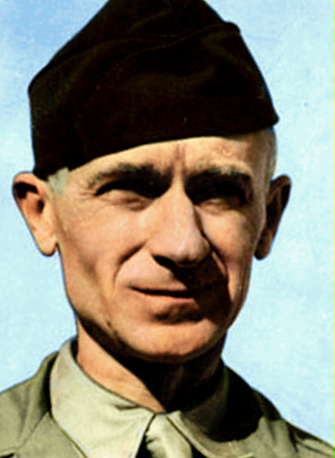The Pittsburgh Press (March 21, 1945)

Roving Reporter
By Ernie Pyle
IN THE WESTERN PACIFIC (delayed) – Destroyers love to pick up airplane pilots out of the ocean. When they rescued our Lt. Jimmy Van Fleet, of Findlay, Ohio, after his plane had plunged over the side, it was pilot-rescue No. 15 for them.
They keep a box score on it, just as carriers keep score of the planes they shoot down. They even keep records of their speed, and try to break records. They fished out Jimmy seven minutes after he went over. Their record rescue is three minutes.
On the destroyer they put Jimmy to bed, got the water out of him and some morphine into him, and sewed up the gash on his head. The doctor joked as he sewed, telling Jimmy he was sorry he couldn’t find a bigger needle so it would hurt more.
Jimmy was nightmarish all night. He didn’t get sick at his stomach until next morning, when he tried to get some breakfast down. He had a headache next day, but after that he was all right.
Destroyers treat rescued pilots as though they were kings. They put Jimmy up in the skipper’s private cabin, since the skipper was on the bridge day and night anyhow.
Jimmy wore the skipper’s bathrobe and house slippers and underwear. The skipper came in a couple of times to take a bath, and actually apologized for intruding.
Fishing out pilots is such a frequent occurrence that the skipper even keeps a bundle of brand-new toothbrushes in his medicine cabinet for such sudden guests.
Scroll prepared for pilots
By the time Jimmy came to, the laundry had washed and pressed his clothes. He didn’t have his wallet with him, so his pictures and private papers were spared a dunking.
This certain destroyer has fished out so many pilots that they have a scroll already printed for such cases, and all they have to do is fill in the name. It’s a picturesque certificate like you get when you cross the Equator.
Across the top of Jimmy’s scroll was engraved the words, “The Blank’s Home for Dripping Aviators.”
And beneath it was this:
Know ye that Lt. James Van Fleet on such and such a date abruptly appeared into our happy home, and due to the peculiarities of his arrival has been found worthy of being honored as a Blank’s Dripping Aviator.
Engraved over the scroll was a huge arm reaching out from a destroyer, hauling a wet flier out of the ocean by the seat of his pants.
Ice cream for the destroyer
They returned Jimmy to us three days later, when they were delivering messages and mail from the flagship. They sent him over in a boson’s chair, pulled across on a heavy line strung between the two ships.
We got Jimmy aboard, and then we sent something back across in the chair to the destroyer. You’d never guess what it was. It was 20 gallons of ice cream!
Our carrier always does that when a destroyer rescues one of our pilots. Apparently, all carriers don’t, for the destroyer sent back a scribbled note saying, “Thanks a lot. That is the nicest thing that has ever happened to us.”
After they told me the whole story, we sent a signal back to the destroyer asking for the names of the two men who rescued him. The destroyer came right back–
The swimmer was Seaman Franklin Calloway of Philadelphia, and the one who helped was Petty Officer Melvin Collins, of Ottumwa, Iowa.
They’re smart on that destroyer. Because a few hours later here came another message saying, “If that information is for the press, might add that both men received Bronze Stars for similar rescue work during operations off Leyte last fall!”
Former schoolteacher
Jimmy Van Fleet is 25, and incongruous as it seems, was a schoolteacher before he became a fighter pilot in the Navy. He has a son seven months old whom he has never seen.
Jimmy asked me if I had ever been in Vienna. He said that was his dad’s “dream city.” His father was a Pfc. in the last war, and spent three years in a hospital in Vienna, and always has wanted to go back.
These columns are probably the first news Jimmy’s folks have had of his little midocean escapade. It is glorious news alongside the last grave message they had.
For Jimmy’s only brother, Ens. Donald Van Fleet, also a carrier pilot, was killed off Formosa just a few months ago. He had got two Jap planes in the two weeks before he himself was shot down. We are grateful that the sea gave Jimmy back.